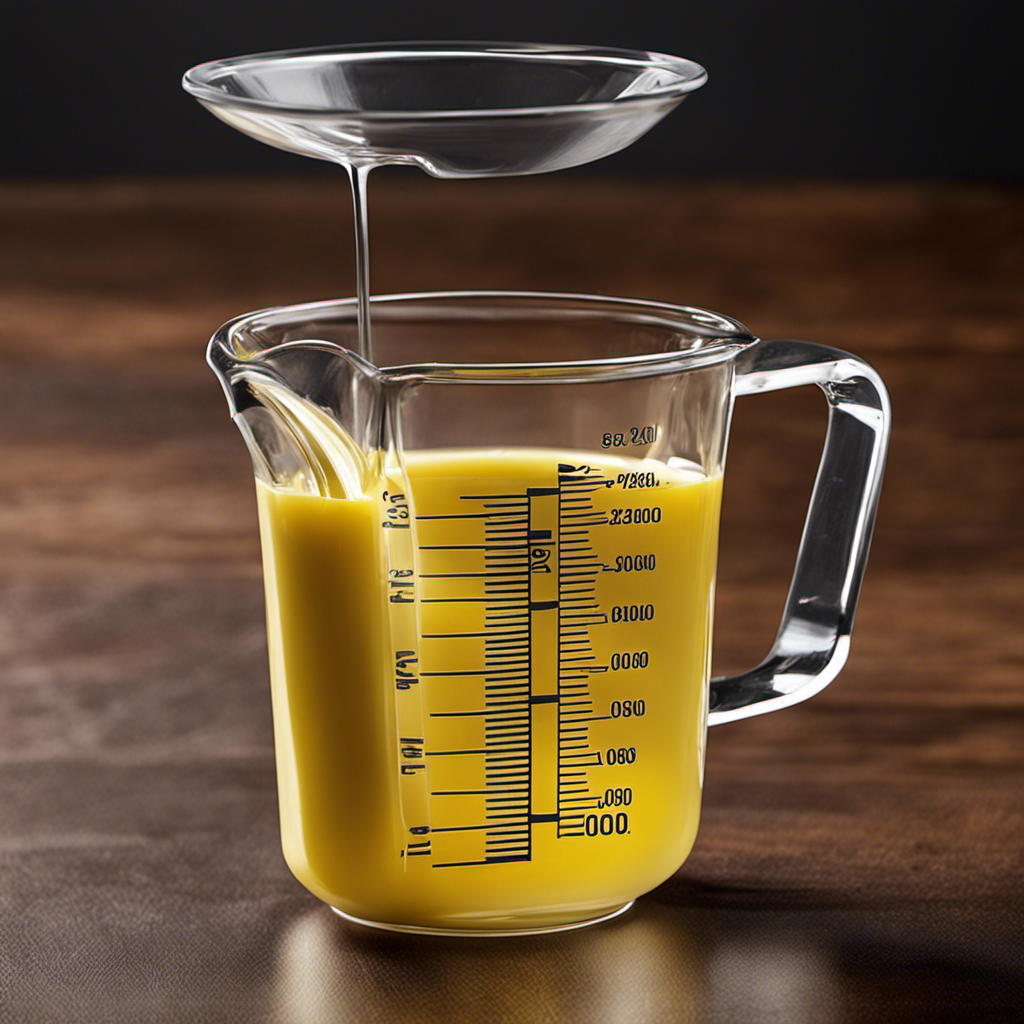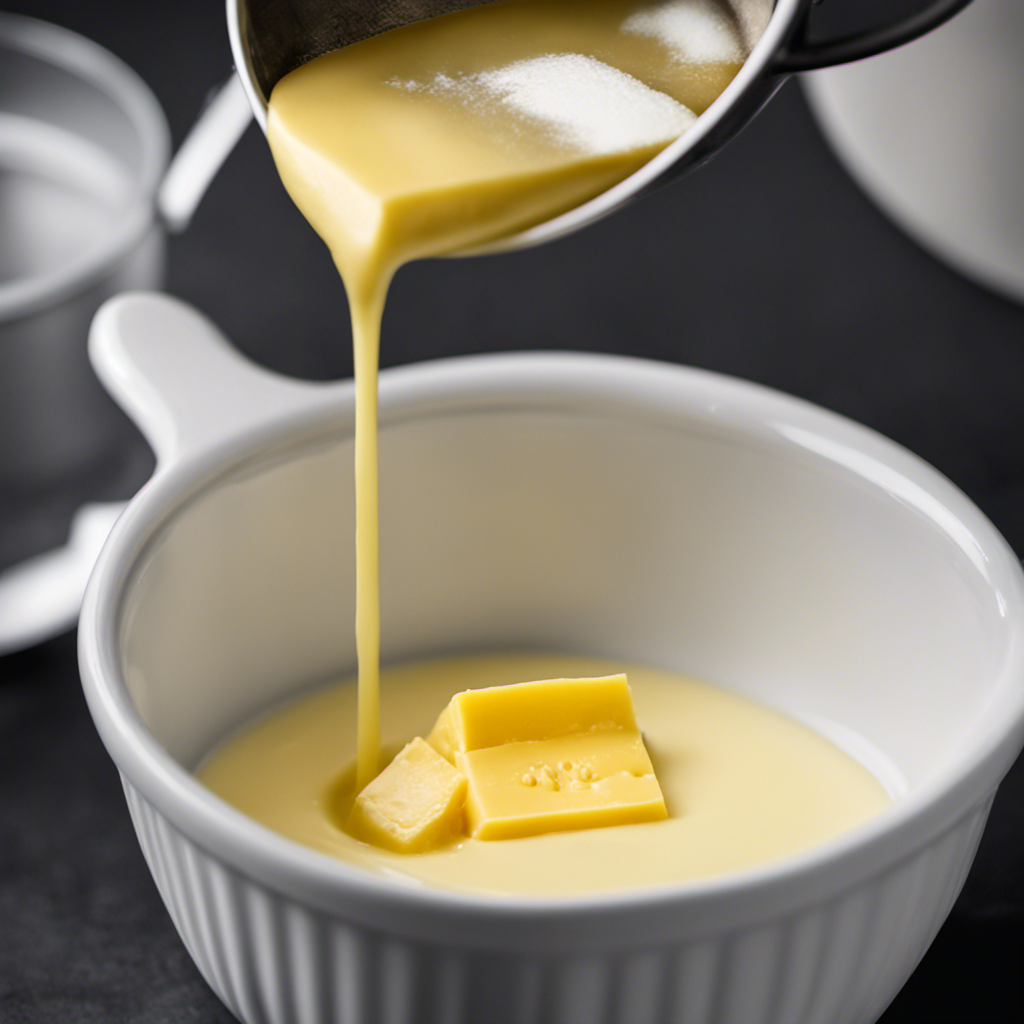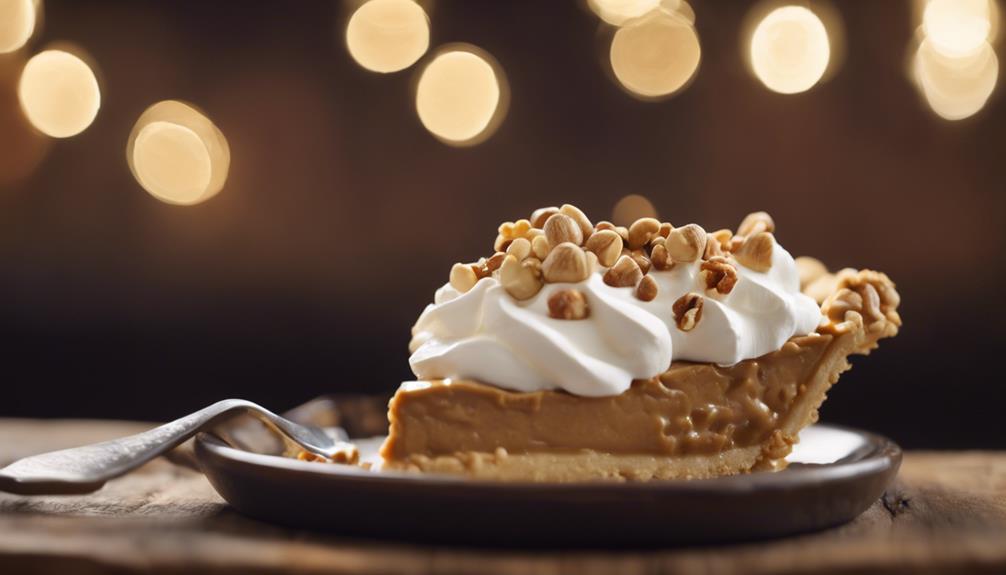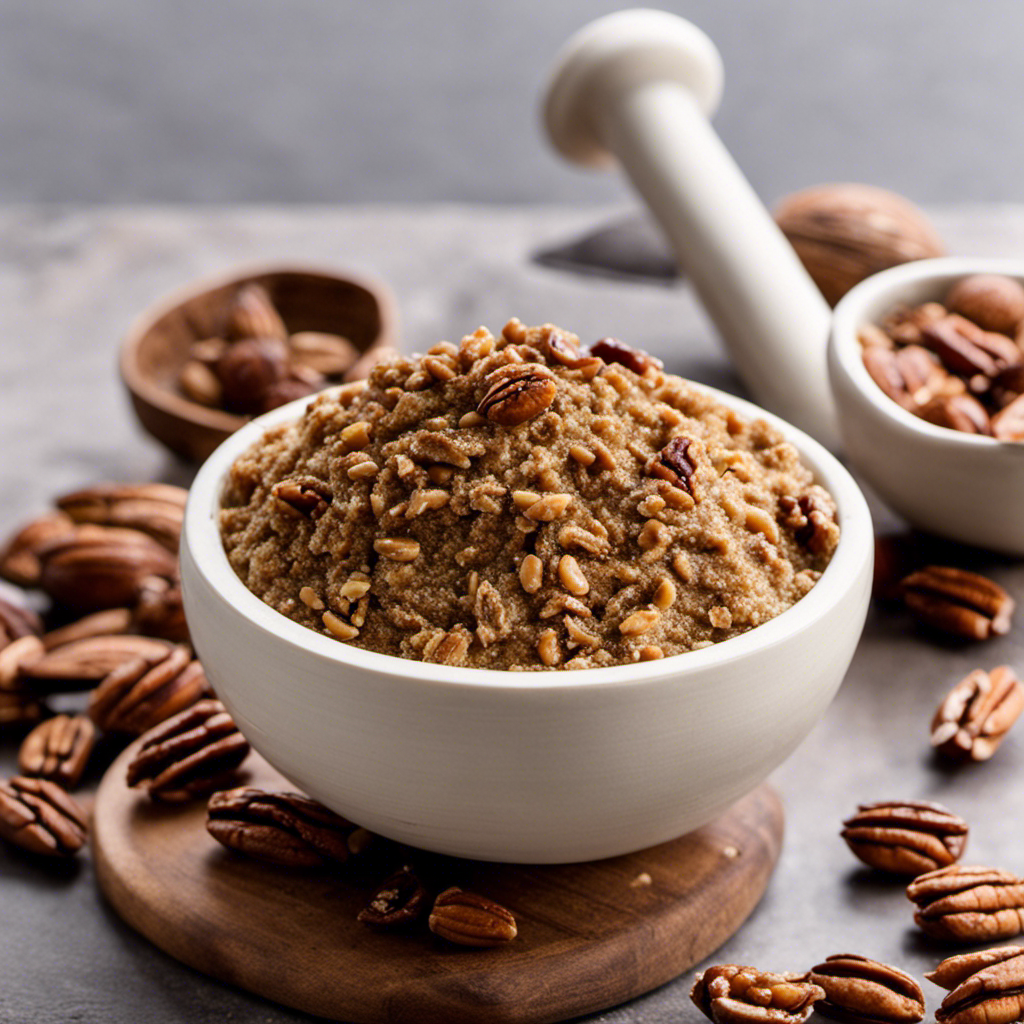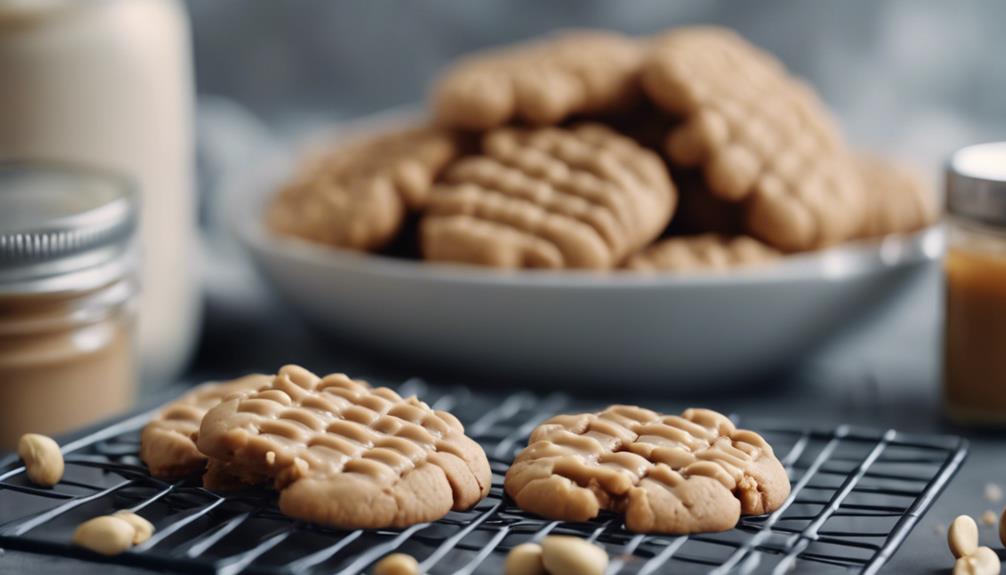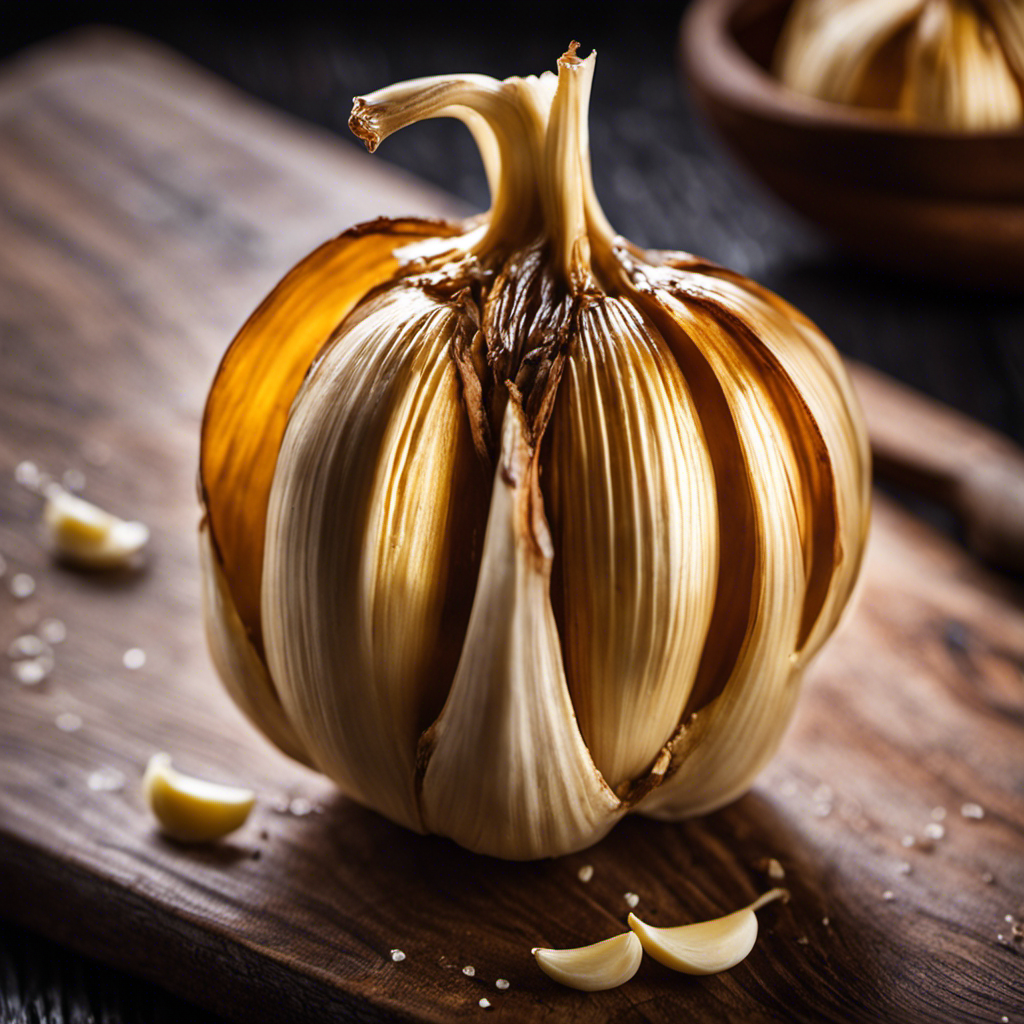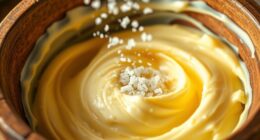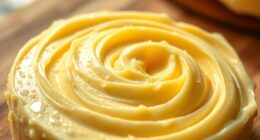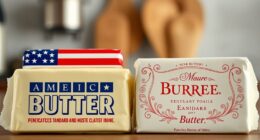I have always been curious about the number of tablespoons in 3 ounces of butter. This is a frequently asked question in the kitchen, especially when following a recipe or trying to measure the exact amount for baking.
In this article, we’ll dive into the world of measurements, exploring the difference between ounces and tablespoons and providing a quick guide on converting between the two.
So, if you’re ready to master the art of butter measurement, let’s get started!
Key Takeaways
- Tablespoons provide a more precise and consistent measurement compared to ounces when measuring butter.
- Understanding the conversion ratio of 1 oz of butter to 2 tablespoons is important for accurate measurements.
- Using a kitchen scale allows for precise and accurate measurements of butter, eliminating the need for conversions.
- Paying attention to the density of different types of butter and using a kitchen scale ensures the correct amount of butter in recipes.
Understanding the Measurement: Ounces Vs. Tablespoons
Ounces and tablespoons are different measurements. When it comes to precision in measuring, tablespoons offer distinct advantages.
Tablespoons are a unit of volume commonly used in cooking to measure ingredients like butter, oil, or spices. They provide a more precise measurement compared to ounces, which are a unit of weight. This is especially helpful when following recipes that require accurate proportions.
Tablespoons allow for better control and consistency in cooking, ensuring that the right amount of an ingredient is used. Additionally, using tablespoons eliminates the need for converting between weight and volume, making it easier to follow recipes without any confusion.
Overall, tablespoons offer a convenient and accurate way to measure ingredients in the kitchen.
Converting Ounces to Tablespoons: A Quick Guide
Converting 3 oz of butter to tablespoons is a quick and easy process. To help you understand the conversion ratio, here’s a step-by-step guide:
- First, you need to know that 1 oz is equal to 2 tablespoons.
- Next, divide the given amount of butter, which is 3 oz, by the conversion ratio of 1 oz to 2 tablespoons.
- By dividing 3 oz by 1 oz, you get 3.
- Now, multiply 3 by the conversion ratio of 2 tablespoons per 1 oz.
- The result is 6 tablespoons. Therefore, 3 oz of butter is equivalent to 6 tablespoons.
Understanding the conversion ratio and converting butter ratios is essential in culinary measurements. It allows you to accurately measure ingredients and follow recipes.
Now, let’s dive into the standard conversion ratio: ounces to tablespoons.
The Standard Conversion Ratio: Ounces to Tablespoons
Understanding the standard conversion ratio is important for accurately measuring ingredients and following recipes in the culinary world. When it comes to understanding ounces and calculating ratios, it is crucial to know that 1 fluid ounce is equivalent to 2 tablespoons.
This means that if you have 3 ounces of a particular ingredient, you can easily determine that it is equal to 6 tablespoons. This information is particularly useful when measuring smaller quantities of ingredients, as it allows for precise and consistent measurements.
Now that we have a clear understanding of the standard conversion ratio, let’s delve into the specific question of how many tablespoons are in 3 ounces of butter.
Measuring Butter: How Many Tablespoons in 3 Ounces
Now that we’ve got the standard conversion ratio down, let’s figure out how much 3 ounces of butter translates to in tablespoons. Understanding butter density is key to accurately measuring it.
Here’s a breakdown of how to measure 3 ounces of butter in tablespoons:
-
Start by converting ounces to grams, as butter is often measured in grams. 1 ounce is equal to approximately 28.35 grams.
-
Next, calculate the grams of butter in 3 ounces. Multiply 28.35 grams by 3, which gives us 85.05 grams.
-
Finally, convert grams to tablespoons. The density of butter is approximately 14.2 grams per tablespoon. Divide 85.05 grams by 14.2 grams per tablespoon, and we get approximately 5.99 tablespoons.
Therefore, 3 ounces of butter is approximately equal to 5.99 tablespoons.
Tablespoons: The Preferred Unit for Butter Measurement
Butter measurement conversions can be a tricky task, especially when trying to convert between tablespoons and ounces.
In this discussion, we will explore why tablespoons are the preferred unit for measuring butter and how they differ from ounces.
Additionally, we will delve into the importance of precision in butter measurement to ensure accurate and consistent results in our culinary endeavors.
Butter Measurement Conversions
To convert 3 oz of butter to tablespoons, you’ll need to know the measurement equivalency. Butter measurement tools like scales or measuring cups can help you accurately measure the butter.
Here are some alternative butter measurements you might encounter:
- 1 stick of butter is equal to 8 tablespoons or 4 ounces.
- 1/2 stick of butter is equal to 4 tablespoons or 2 ounces.
- 1/4 stick of butter is equal to 2 tablespoons or 1 ounce.
Knowing these equivalencies can be useful when following recipes that require precise measurements of butter. By understanding the conversions, you’ll be able to accurately measure the right amount of butter needed for your culinary creations.
Tablespoons Vs. Ounces
Understanding the difference between tablespoons and ounces can help you accurately measure ingredients in your recipes. When it comes to butter, the consistency can vary depending on its temperature. Softened butter, for example, is easier to measure in tablespoons, while melted butter is typically measured in ounces.
To convert tablespoons to ounces, it’s important to know that 1 tablespoon of butter is equal to 0.5 ounces. This means that if your recipe calls for 3 ounces of butter, you would need 6 tablespoons.
Alternatively, if you only have tablespoons available, you can use a conversion chart or online calculator to determine the equivalent measurement in ounces. This can be particularly useful when working with recipes that require precise measurements.
Precision in Butter Measurement
When measuring ingredients for your recipes, it’s crucial to be precise and accurate, especially when it comes to butter. Butter measurement accuracy is essential to ensure the desired taste and texture of your culinary creations.
To achieve this accuracy, it is important to understand how to convert butter ratios accurately. Here are three key points to consider:
-
Use a kitchen scale: Weighing butter on a kitchen scale provides the most precise measurement. This eliminates any inconsistencies that can occur when using measuring spoons or cups.
-
Convert butter ratios: Many recipes provide measurements in ounces, but you may prefer to use tablespoons. To convert, keep in mind that one ounce of butter is equal to two tablespoons. Adjust your measurements accordingly.
-
Be aware of variations: Different types of butter may have slightly different densities, which can affect the measurements. Pay attention to the specific type of butter mentioned in your recipe and adjust as necessary.
Using a Kitchen Scale for Accurate Butter Measurement
You can easily measure butter accurately by using a kitchen scale, so there’s no need to guess the number of tablespoons in 3 oz. Using a kitchen scale provides several benefits when it comes to measuring ingredients, including butter. It allows for precise and accurate measurements, removing any room for error. With a kitchen scale, you can measure butter in ounces, grams, or any other unit of weight, ensuring consistency in your recipes. As an alternative to tablespoons, here is a table that shows the equivalent measurements for 3 oz of butter:
| Measurement | Amount |
|---|---|
| Cups | 0.375 |
| Tablespoons | 6 |
| Teaspoons | 18 |
| Grams | 85 |
| Ounces | 3 |
With this handy table, you can easily convert between different measurements and accurately measure 3 oz of butter for your recipes.
Converting Butter Measurements: Ounces to Tablespoons Made Easy
When it comes to accurately measuring tablespoons, precision is key. By using proper measuring techniques, such as leveling off the spoon and ensuring the ingredients are evenly distributed, you can achieve accurate tablespoon measurements every time.
Additionally, understanding how to convert butter ratios from ounces to tablespoons can be incredibly useful in recipes that call for specific amounts of butter. By following these guidelines, you can ensure precise measurements and achieve the desired results in your culinary endeavors.
Accurate Tablespoon Measurement
To accurately measure tablespoons of butter, it’s important to know the conversion from ounces. Here are three key factors to consider when aiming for accurate tablespoon measurements:
-
Consistency: When measuring butter, it’s crucial to ensure that it is at room temperature. This ensures that the butter is soft and pliable, making it easier to measure accurately.
-
Precision: Use a kitchen scale to measure the exact weight of the butter in ounces. This eliminates any guesswork and guarantees precise measurements.
-
Conversion: Remember that 1 ounce of butter is equal to 2 tablespoons. Knowing this conversion allows you to calculate the exact number of tablespoons needed for your recipe.
Accurate tablespoon measurements are vital in cooking and baking. Precise measurements ensure that your dish turns out as intended, with the right balance of flavors and textures. So, take the time to measure your butter accurately, and enjoy the perfect results in your culinary creations.
Converting Butter Ratios
Remember, it’s important to understand the conversion ratios when working with different types of butter in your recipes. One key factor to consider is butter density. Butter density refers to the weight of butter in a specific volume.
To convert tablespoons to grams, you need to know the density of the butter you are using. The general conversion ratio is 1 tablespoon of butter equals approximately 14 grams. However, this can vary depending on the density of the specific brand or type of butter. To be precise, it’s advisable to check the label or use a kitchen scale for accurate measurements.
Understanding butter density and converting tablespoons to grams will ensure that you add the correct amount of butter to your recipes, resulting in delicious and consistent dishes.
Now, let’s move on to some handy tips for measuring butter in tablespoons.
Handy Tips for Measuring Butter in Tablespoons
Here’s a handy tip: 3 oz of butter is equivalent to 6 tablespoons. When it comes to measuring butter alternatives, it’s important to know the conversions from grams to tablespoons.
Here are three useful tips to help you navigate the world of butter measurements:
-
Start by understanding the standard conversion: 1 oz of butter is equal to 2 tablespoons. So, 3 oz would be 6 tablespoons.
-
If you have a recipe that calls for a specific gram measurement of butter, you can use an online converter to determine the corresponding tablespoon measurement. Just enter the grams and it will give you the precise amount in tablespoons.
-
Remember that the density of butter can vary slightly depending on factors like temperature and brand. So, it’s always a good idea to measure butter using a kitchen scale for accurate results.
Frequently Asked Questions
Can I Use a Different Unit of Measurement, Like Grams, to Measure Butter Instead of Tablespoons?
Yes, alternative measurements such as grams can be used to measure butter instead of tablespoons. Converting 3 oz of butter to grams would give you the precise amount needed for your recipe.
How Do I Convert Tablespoons of Butter to Cups?
To convert tablespoons of butter to cups, it’s important to know that 1 cup equals 16 tablespoons. To measure accurately, use a measuring spoon or scale. Following these tips ensures precise butter measurements in your recipes.
Is It Necessary to Use a Kitchen Scale for Measuring Butter Accurately?
Yes, a kitchen scale is necessary for accurate measurements. It allows for precise weighing of ingredients, such as butter, ensuring consistent results in recipes. Eyeballing or using measuring spoons may lead to variations in quantity.
Are There Any Substitutes for Butter That Can Be Used in Recipes?
Butter alternatives, such as vegan butter substitutes, can be used in recipes as a substitute for butter. These alternatives provide a similar texture and flavor, making them a suitable option for those who cannot or choose not to use butter.
How Do I Measure Butter if I Don’t Have a Tablespoon Measuring Spoon?
To measure butter without a tablespoon measuring spoon, you can use alternative measurement methods. One way is to convert ounces to tablespoons. For example, 3 oz of butter is equivalent to 6 tablespoons.
Conclusion
In conclusion, understanding the conversion between ounces and tablespoons is crucial for accurate butter measurement in the kitchen.
With 3 ounces of butter, you would need approximately 6 tablespoons. However, to ensure precise measurements, using a kitchen scale is recommended.
By following these handy tips and converting butter measurements from ounces to tablespoons, you can confidently create delicious recipes with the perfect amount of butter.
So, next time you’re in the kitchen, remember the importance of tablespoons and enjoy the art of precise butter measurement.
